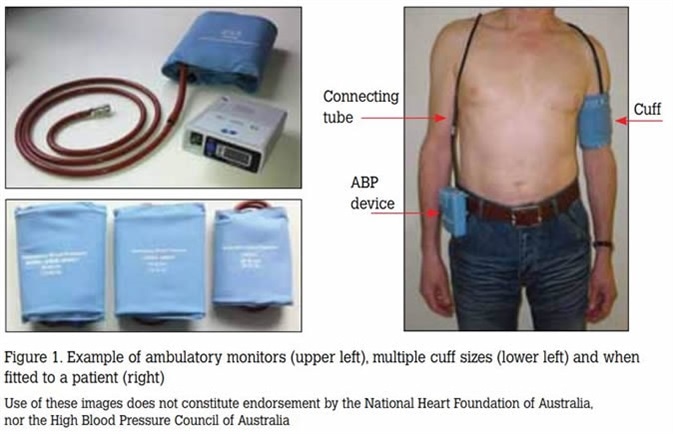
Ambulatory Blood Pressure Monitoring
Ambulatory Blood Pressure Monitoring (ABPM) is a diagnostic test to determine the presence of hypertension by taking measurements during normal daily activities, over a span of 24 consecutive hours. It helps to diagnose as well as monitor high blood pressure, usually defined as a systolic pressure of 140 mm Hg or more and a diastolic pressure of 90 mm Hg or more.
The instrument used is a portable blood pressure machine worn as a belt, with the cuff being attached around the upper arm. All types of daily activities, including sleep, may be normally carried out while wearing this device.

Image Credit: National Heart Foundation and High Blood Pressure Research Council of Australia Ambulatory Blood Pressure Monitoring Consensus Committee
Why a 24-Hour Measurement of Blood Pressure
During the ABPM, regular blood pressure readings are taken, for several reasons:
- The normal variations in blood pressure are mirrored in this test as it takes many measurements unlike the one or two during a normal clinic visit
- It eliminates the “white coat effect” which means that blood pressure measurements taken by a doctor in a clinic are on average 9/7 mm Hg (systolic/diastolic pressure) higher than corresponding readings obtained by a nurse or other trained practitioner in the same setting
- It can detect masked and sustained hypertension – when the blood pressure reading is normal in the clinic but high during normal activity, it is termed ‘masked hypertension’, whereas a persistently high blood pressure is called sustained hypertension and is associated with higher risk of heart attacks and renal injury
- It shows the normotensive effect of current medications, that is, the effect of medications on controlling the blood pressure throughout the day can be visualized
- It reveals if the blood pressure increases at night or during sleep, a phenomenon seen in some individuals, which may need an adjustment in the medical regimen
- It also shows the heart rate at the same time
- It yields the average or mean blood pressure, heart rate and a few other parameters
- It helps predict the chances of stroke or heart attacks
How ABPM is Performed
The ABPM monitor is attached at the outpatient clinic. A digital monitor is used in the same way as in any clinic, by a cuff which inflates and then slowly deflates. Readings are taken at about every 15-30 minutes throughout the day and every half-hour to one hour at night. The cuff is worn throughout the period, with the machine being kept under the pillow or besides the patient on the bed during sleep.
The patient undergoing the measurement must not change the normal routine to enable a more accurate picture of how the blood pressure changes with various phases of daily activity. However, the machine, being electronic, cannot tolerate wet conditions, and therefore swimming, bathing or showering must be avoided for the day.
The machine has the ability to store all the readings which are analyzed once it is removed and taken back to the clinic or hospital. When a reading is about to be taken, the machine utters a warning beep. At this point, a few things should be done:
- A rapid check to see that the cuff tube is not kinked or bent
- Assuming a seated posture if possible
- The arm with the cuff should be kept at the same level as the heart
- The arm should not be moved
- Talking is to be avoided
- A quick note should be made of the current activity at the time of the reading, and also of the time of retiring to bed, waking, and details of whether medication was taken with the time.
Some individuals feel uncomfortable with ABPM and their readings may therefore be unreliable as it reflects this emotional reaction. Such feelings should therefore be communicated to the doctor as this test may fail to be of value for these individuals.
Other Indications for ABPM
ABPM is also useful in:
- Surveillance of pregnancy with hypertension
- Monitoring borderline hypertension
- Fluctuating hypertension
- Change of medications for hypertension to monitor changes in the blood pressure as a result
- Refractory hypertension
- Ambulatory BP monitoring may also be suitable in other situations, such as for episodes of hypotension or fainting
Benefits of ABPM
By giving an accurate picture of a patient’s blood pressure throughout the day and during sleep, it can prevent unnecessary prescribing of hypertension-reducing drugs for white coat hypertension. It also helps patients with masked hypertension to receive required treatment. It reduces the risk of stroke, heart disease, and organ damage caused by hypertension, and also shows how well a person responds to a long-acting antihypertensive drug.
Disadvantages of ABPM
Some patients do not tolerate the repeated cuff inflation well, and complain of soreness of the upper arm. Others feel tense or are distracted from their work by the regular taking of measurements. Sometimes skin irritation or even a slight reddening may occur.
Last Updated: Sep 3, 2018























.png)









No hay comentarios:
Publicar un comentario